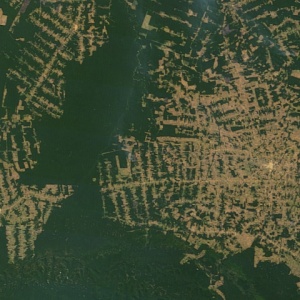
Around 15% of the carbon dioxide emissions from food consumption in the European Union are due to deforestation, according to this paper, which traces the links between final consumers and the expansion of agriculture (including both crops and pasture) and tree plantations into tropical forests. Depending on the model used, 29% to 39% of tropical deforestation emissions were attributed to the production of goods for export.
The paper finds that tropical deforestation for agriculture and tree plantations caused around 2.6 Gt CO2 of emissions per year between 2010 and 2014. For comparison, annual carbon dioxide emissions from fossil fuels and industry were approximately 34 Gt CO2 eq. per year between 2008 and 2017 (source).
The commodities to which these deforestation emissions can be attributed are shown in the figure below. The figure includes commodities produced both for export and for domestic consumption. In Brazil, beef production (including both exported beef and domestically consumed beef) accounts for nearly three-quarters of Brazil’s emissions from deforestation. In Indonesia, nearly half of deforestation emissions are from oilseeds (while that category includes both palm oil and soybeans, in Indonesia almost all oilseed cultivation is palm oil rather than soybeans). In Africa, a diverse mix of commodities are linked to deforestation emissions, including vegetables, cereals and rice.
 Image: Figure 1, Pendrill et al. Emissions sources for deforestation-related carbon dioxide emissions are diverse and vary by region. Emissions embodied in production are quantified for each commodity group within each country (here summarised by region). A region’s width on the x-axis corresponds to the embodied emissions produced in that region, while the y-axis shows the share of emission attributed to each commodity group within each region, implying that the rectangles within the plot are scaled according to the emissions embodied in each region-commodity combination. The percentages within the rectangles indicate the share of the total (2.6 GtCO2 yr−1) embodied emissions. For forestry products, the results show emissions associated with tree-plantation expansion, but not emissions due to clearing purely for timber without subsequent land-use expansion.
Image: Figure 1, Pendrill et al. Emissions sources for deforestation-related carbon dioxide emissions are diverse and vary by region. Emissions embodied in production are quantified for each commodity group within each country (here summarised by region). A region’s width on the x-axis corresponds to the embodied emissions produced in that region, while the y-axis shows the share of emission attributed to each commodity group within each region, implying that the rectangles within the plot are scaled according to the emissions embodied in each region-commodity combination. The percentages within the rectangles indicate the share of the total (2.6 GtCO2 yr−1) embodied emissions. For forestry products, the results show emissions associated with tree-plantation expansion, but not emissions due to clearing purely for timber without subsequent land-use expansion.
23% to 34% (depending on the model used) of Latin America’s deforestation emissions are caused by commodities that are exported, with most oilseeds being exported and most beef being consumed directly. 44% to 49% of deforestation emissions from the Asia-Pacific region are from exported commodities, and 9% to 32% of those from Africa are due to export.
The figure below shows the per capita deforestation emissions from the diet of different countries. Brazil has the largest deforestation dietary emissions, largely due to high consumption (in Brazil) of beef produced in Brazil. In the European Union (EU), the average deforestation dietary emissions are 0.3 t CO2 per person per year, which is around one sixth of total estimated dietary emissions in the EU.

Image: Figure 5, Pendrill et al. The average (2010–2014) deforestation carbon footprint for food consumption across countries. MRIO = multi-regional input output model.
Abstract
Deforestation, the second largest source of anthropogenic greenhouse gas emissions, is largely driven by expanding forestry and agriculture. However, despite agricultural expansion being increasingly driven by foreign demand, the links between deforestation and foreign demand for agricultural commodities have only been partially mapped. Here we present a pan-tropical quantification of carbon emissions from deforestation associated with the expansion of agriculture and forest plantations, and trace embodied emissions through global supply chains to consumers. We find that in the period 2010–2014, expansion of agriculture and tree plantations into forests across the tropics was associated with net emissions of approximately 2.6 gigatonnes carbon dioxide per year. Cattle and oilseed products account for over half of these emissions. Europe and China are major importers, and for many developed countries, deforestation emissions embodied in imports rival or exceed emissions from domestic agriculture. Depending on the trade model used, 29–39% of deforestation-related emissions were driven by international trade. This is substantially higher than the share of fossil carbon emissions embodied in trade, indicating that efforts to reduce greenhouse gas emissions from land-use change need to consider the role of international demand in driving deforestation. Additionally, we find that deforestation emissions are similar to, or larger than, other emissions in the carbon footprint of key forest-risk commodities. Similarly, deforestation emissions constitute a substantial share (˜15%) of the total carbon footprint of food consumption in EU countries. This highlights the need for consumption-based accounts to include emissions from deforestation, and for the implementation of policy measures that cross these international supply-chains if deforestation emissions are to be effectively reduced.
Reference
Pendrill, F., Persson, U.M., Godar, J., Kastner, T., Moran, D., Schmidt, S. and Wood, R., 2019. Agricultural and forestry trade drives large share of tropical deforestation emissions. Global Environmental Change, 56, pp.1-10.
Read the full paper here. See also the Foodsource resource How do food systems affect land-use and biodiversity? and the paper Deforestation displaced: trade in forest-risk commodities and the prospects for a global forest transition.







Post a new comment »